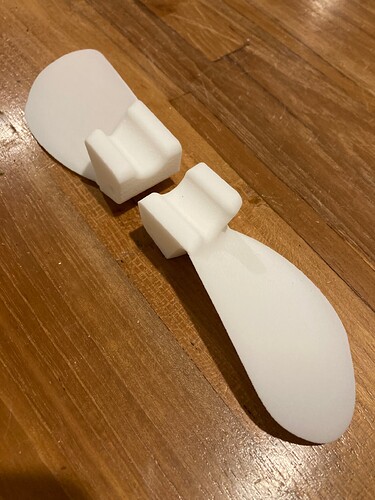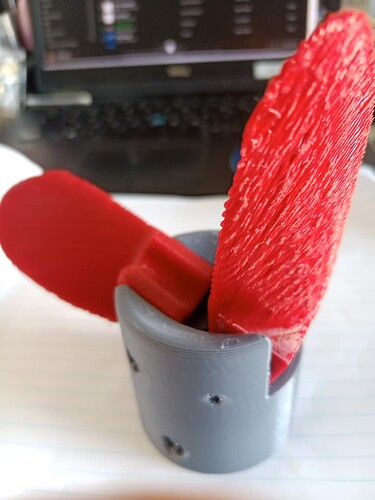I’ve printed a set of the props in SLS nylon.
Nice smooth finish.
Cost $15 per prop with a commercial printer.
SLS would indeed be great for making those blades, as otherwise, the presence of supports typically means that the surface finish is rough and needs epoxying/sanding or some kind of time consuming treatment.
Being small parts makes it affordable to get them made by professional outfits, while the chunky hub itself can be printed at home in less refined material
Why not rotate the blade and print standing?
what about making a negative mold in epoxy resin/fiber glass and make the propellers out of carbon?
You’re right, I assumed that the print would be stronger like that, and weaker along the Z axis, but that’s just an assumption, and I’m not at any testing stage to see if there’s any truth to it or not. Not even sure I’d end up with this type of prop. Just printed one in PLA+ for now, for tinkering purposes.
And there’s plenty of wind and waves at the moment for some good old fashioned foiling to delay whatever side project I have in mind.
Just an idea of mixed technology folding propeller. As 1-3d printed folding blades tend to break easily 2-since CNC time is costly and 3- it is easier to mold two or three small alu parts rather than a big prop…
@jeffM, do you think you could mold a pair of small foldable quality prop blades with your aluminium casting process ? I have moulded blades in mind mounted on a 3D printed hub, if it can resist to repeated ‘violent’ blade openings. If not the hub could also be moulded in aluminium. Then comes the delicate step of balancing.

Pict credit to @Foil_A_Lot
If the violent blade opening is causing failure, could we add a pad of damping material to soften the blade opening, much like the Flexo-drive folding boat propellors use?
I haven’t seen much information on whether people have tested non-brittle filaments for the folding blades such as nylon+glass, or even PLA-ST (which has much higher impact toughness than PLA/PLA+ which are both known to be very brittle).
My assumption. Worth a try and easy to implement … especially if boats are already using this to dampen the opening shock impact supposedly detrimental to folding blade life duration.
Some interesting figures comparing toughness of ePLA-ST compared to regular PLA:
- Elongation at break for PLA-ST is 90%. Regular PLA is 5%, PLA+ is 29%. PLA-ST is much less brittle.
- Izod Impact Strength (receiving a sharp blow): PLA-ST absorbs 63 KJ/m2, where regular PLA is only 4.2 KJ/M2 and PLA+ is 7 KJ/M2. ePAHT-CF absorbs 12.74 KJ/M2 (nylon with carbon fibre). PETG is around 8 KJ/M2. Therefore PLA-ST is 10x as impact tough as other PLA filament.
- The bending strength of PLA-ST is 44 MPa, compared to PLA 90 Mpa and PLA+ 75 MPa, so it’s not as strong overall.
If it is the impact/shock of the propellor opening that breaks it, then PLA-ST might be a lot more durable. It’s not very expensive, I’ll probably give it a try when I put together my assist build.
The problem with aluminum casting is the thickness of the blades. it is difficult to have a good result if the thickness is less than 2.5 mm
This problem of the aluminium casting (mnimal thickness of 2.5 mm) can be easily eliminated by first casting the blade in a rough shape, then precisely machining this rough casting on a CNC mill. I believe this technology of making a folding propeller is commonly used. I guess the hardest part would be finding someone in the EU to produce such castings.
Would be as easy to mill the blade from a bloc. Never easy to register on a cast. Also an aluminium cast will never have the mechanical property of a part milled from a billet
I would also like to clarify that propeller casting (and any subsequent precision machining on a CNC mill, if necessary) has been used, I believe, for many decades for 99% of all propellers produced in the world (except for RC model propellers). And it’s made of every kind of metal alloy that comes to mind - aluminum alloys, bronze alloys, steel alloys, … In addition, it is also worth considering that separate blades for the folding propeller (for e-foil propulsion) can be successfully made from high quality plastic, simply by casting without pressure. In this case, it is possible to produce the mould very accurately and very cheaply, e.g. using a 3D printer.
any updates on the testing of this optimized prop?
My final design works for me since more than 10 Sessions without any problems:
Great info everybody, (thanks to SoEfoil for pointing me in this direction) this is just the thing I’m looking for.
Ive started a thread to create a budget designed and produced bronze folding propeller for less than 200€ to see if anyone on the forum would be interested.
https://foil.zone/t/community-designed-produced-folding-propellor/16532/3
The work you guys have already done is great and answered some of the questions I have about the project. I do have some more though if you don’t mind?
Is it really necessary for a metal version (apart from the ‘BLING!’ factor)? I saw some durability issues early on but it seems some of you have your 3D printed props pretty much dialled in now?
Im also interested in what the most common motor attachment is for the hub, (80100, Flipsky etc) so we can cast the most popular hubs first and get a wider data pool of testing for optimising blades.
Last question for now, would there be anyone with data logging capabilities be willing to test prototypes? Preferably in Europe to save time/money on shipping.
Thanks everybody
mani
Sorry, I forgot one thing.
Id just like to check with @leachim and @superlefax if its ok to adapt and cast in metal your 3D models.
mani
Superlefax has set a store up based on his folding prop:
How was the durability of the SLS nylon for prop blades?
Hay Mani, have you found a way to cast one of the folding props and test different hubs ?

